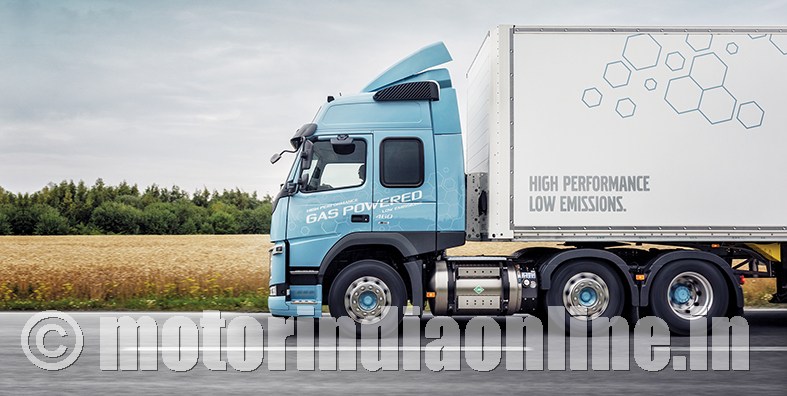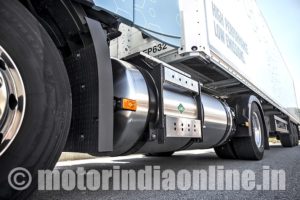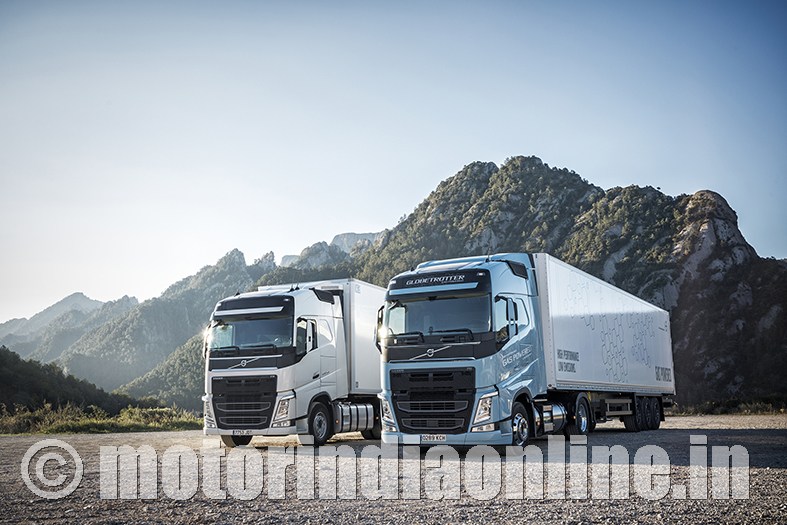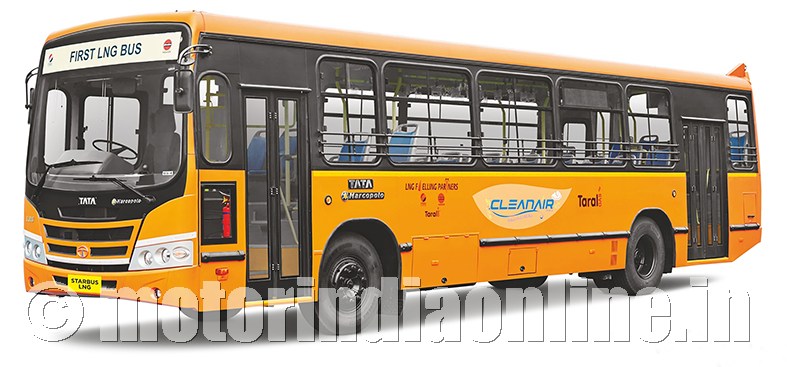Amid all electrification debates in the transportation sector, global CV makers are stepping up their ‘gas’ pedals to the mitigate the climate impact of the trucking industry! They are betting high on liquefied natural gas (LNG) or biogas (renewable natural gas) as a pragmatic alternative to conventional diesel for heavy regional and long-haul trucking operations, especially in Europe. They claim that LNG offers considerable environmental and public health benefits with 20 per cent lower CO2 emissions than diesel, even up to 100 per cent emission cut by using bio-LNG, thereby realizing sustainable, eco-friendly haulage. It also promises reduced nitrogen oxide (NOx) emissions, with virtually no particulate emissions, while LNG-powered engines are said to be significantly quieter than conventional diesels.
Volvo Trucks, for instance, has just unveiled the first-ever gas-powered truck in the European market. The company is now working together with gas suppliers and customers to expand the LNG infrastructure in Europe. “With the EU making more stringent regulation on CO2 figures for heavy vehicles, we see a clear possibility for increasing LNG market shares as a vital part of the solution to lower emissions”, notes Lars Mårtensson, Director of Environment and Innovation at Volvo Trucks.
Volkswagen Group Logistics, together with Scania, is also in favor of promoting LNG as a truck fuel. It has revealed that more than 100 LNG trucks are to be used on the roads of north Germany in future as a commitment towards sustainable logistics. It is in dialogue with gas suppliers to construct LNG refueling stations in the region. Scania claims that its LNG powertrain, apart from 20-90 per cent less CO2 than diesel engines depending on the choice of fuel, emit some 95 per cent less NOx. Particulate emissions during combustion are virtually completely avoided up to 95 per cent, while the noise levels are curbed by about 50 per cent (-3 db), according to the truck maker.
The Italy-based IVECO, one of the pioneers of natural gas transportation in the industry, has also introduced Stralis NP (natural power) 460 hp truck for long-haul operations. The brand claims up to 95 per cent cut in CO2 emissions by using compressed or liquefied biomethane as fuel. The company already supports a running parc of 22,000 natural gas vehicles across Europe.
Conventional natural gas is fossil fuel-derived, predominantly made up of methane (CH4). Alternatively, renewable natural gas (RNG), a.k.a bio-methane or biogas, can be produced from renewable means like decaying organic materials or bio-waste. But, to be used as a transportation fuel, the natural gas has to be either compressed (CNG) or liquefied (LNG). Notably, the primary source of natural gas determines its ‘cleaner’ credentials.
Both the alternative fuels (CNG and LNG) which can be locally produced even cost less than diesel in many European countries and in India as well. Although CNG is widely used for passenger cars and buses, LNG meets the longer range requirements of trucks, as liquid is denser than gas (CNG) and, so, more energy can be stored by volume in a given tank. Further, the carrying capacity of vehicles powered by LNG is 2.5 times more than that CNG.
Energy experts opine that long-term availability and commercial viability of natural gas is excellent at a global level. Biogas, for instance, thus far has been only produced in limited quantities across the globe. With more and more gas-run products coming up, production of the alternative fuel locally can be amplified in every market.
“All told, this makes liquefied gas the best widely available climate alternative on the market for long and heavy transports. What is needed now is gas-powered truck that can compete with diesel in terms of performance and fuel consumption and continued expansion of the LNG infrastructure. In both cases major progress has been achieved,” observes Mårtensson of Volvo Trucks.
LNG-run Volvo FM, FH Trucks on par with diesels
Volvo Trucks has introduced Euro-6 compliant heavy duty trucks running on liquefied natural gas or biogas in the European market. Offered in 420 or 460 hp power ratings with gross vehicle weights of up to 64 tonnes, the new Volvo FM LNG and Volvo FH LNG will go on sale in the first half of 2018.
Interestingly, the new gas-run trucks have the same performance, driveability and fuel consumption as its diesel counterparts, making it practicable and economical for heavy-duty haulage. The 460 hp LNG engine delivers a maximum torque of 2,300 Nm, while the 420 hp unit generates 2,100 Nm, the same as the diesel powertrains.
Volvo’s new LNG powertrain uses the Diesel cycle technology in place of the Otto cycle engine that is traditionally used for gas-run engines, thereby ensuring no compromise in power and torque output. The SCR and particulate filter are in place for exhaust after-treatment.
To extend the driving range, LNG is stored in cryogenic state at 4-10 bar pressure at a temperature of -140 to -125°C inside the tank. Volvo offers tank capacity for a range of up to 1,000 km. Refuelling time is no different as the diesel. On drive, the fuel has to be warmed up to gas form to be injected into the engine. In order to ignite the gas, a tiny quantity of diesel is added at the moment of injection. To gain absolute eco-compatibility, Volvo is presenting hydrogenated vegetable oils (HVOs) in place of conventional diesel.
LNG in India: Automotive Fuel Revolution?
A lot of action is taking place on the LNG scene in India as well. In August, the Union Government notified revised gas cylinder norms for LNG stations aimed at helping establish a storage and supply chain for refuelling stations through ‘daughter trucks’, just like for CNG stations in Delhi.
Home-grown Tata Motors has taken the lead interest in LNG, with the debut of the country’s first LNG-powered Tata Marcopolo LNG Bus (LPO 1613) in Kerala late last year. In fact, the company was the first OEM here to come up with gas-run heavy truck Prima 4032.S LNG, displayed at 2014 Auto Expo. Eco-friendliness and soft price make it a compelling alternative fuel for the company. LNG is also cheaper than diesel by nearly 40 per cent and almost 15 per cent dearer than CNG as well.
It is also reported that other domestic CV makers, including Ashok Leyland, Mahindra and BharatBenz, are developing LNG variants of their products. Scania, for instance, has already introduced the ED95 engine series (Euro 4-compliant) in its products that can run almost completely on bio-fuels including bio-CNG. On the supply side of LNG, India’s largest importer of LNG Petronet and Reliance Petroleum have expressed their interest in offering LNG at fuel stations.
Yet, the LNG dialogues happening in India are solely related to conventional natural gas that is non-renewable and purely imported. There is a need for a much ‘cleaner’ approach to auto LNG by encouraging local and commercial production of bio-methane. Both the Government and the auto industry have to work together in this regard, so as to extract the real ‘eco’ benefits of using LNG on CVs.



